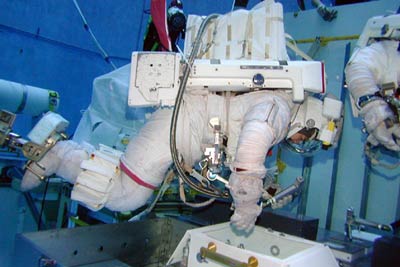Tile repair and shuttle return to flightby Taylor Dinerman
|
| One of the most important of the CAIB’s recommendations was that NASA develop an on-orbit repair capability for the shuttle’s thermal protection system. |
The astronauts will have to ensure that no bubbles form inside the repaired tiles. Once the material is in place the spacewalker will then use a simple brush to shape it to the desired fit. There will be no chance to test the repaired tiles during an actual re-entry, but NASA has already extensively tested the product in a reentry simulator at the Johnson Space Center in Houston. A live test on the shuttle would obviously be far too risky, while the cost of building a separate orbital vehicle to test the repair would be well beyond NASA’s budget. A spaceplane testbed such at the now-canceled X-38 would have been an ideal vehicle with which to carry out such tests, but obviously it or anything like it is not going to be available for a long while to come.
Returning the shuttle to flight status and fulfilling the CAIB recommendations has been a tough job. The agency has been criticized for underestimating the cost of return to flight, yet it seems that NASA has been telling its political masters that it will need a considerable sum of extra money to complete the program. The leadership at NASA was told that, for technical budgetary reasons, they should delay asking for more money for the shuttle, but now the crunch has come and NASA urgently needs the extra budget authority. It is this requirement that will drive the serious budget debate that everyone feels will have to take place after the November election.
| NASA should be looking to leverage as much technology as possible out the work being done to get the shuttle ready to fly again. |
Meanwhile, the development of these on-orbit repair capabilities goes ahead. For the moment these techniques are only applicable to the shuttle. However, the heat shields for the Crew Exploration Vehicle will certainly need to be designed with on-orbit repair on the TPS in mind. Of course, the technology for the shuttle’s tiles is more than thirty years old. While the tiles have shown themselves fairly reliable, there are better and lighter systems available.
Future spacecraft that re-enter the Earth’s atmosphere will have to have a complex, robust, and well-integrated TPS design. It will also have to be easier to repair either in orbit or back on earth than the shuttle’s tiles and RCC. NASA should be looking to leverage as much technology as possible out the work being done to get the shuttle ready to fly again. The agency is getting better at cost control and at breaking down the so called “stovepipes”, but it has not yet fully accepted the new way of doing business.
If the Exploration Systems Mission Directorate finds a role for itself in the development and ongoing operational use of this capability, some of the agency’s milder critics will have to accept that NASA has indeed gotten beyond business as usual. It is almost mathematically certain that future space exploration craft will break down and have to be fixed, both in low Earth orbit and beyond. With the shuttle’s return to flight, NASA has the opportunity to build on the work being done now so as to make it contribute to the technology that will be needed in the future.
